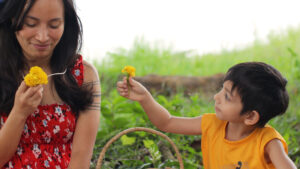Lovely local lullabies for the little ones

TAKING care of children can be very challenging to parents or babysitters, especially when lulling them to sleep. Singing to them might be just the solution.
Crooning “Rock-A-Bye-Baby,” “Twinkle Twinkle Little Star” or any popular English nursery rhyme to pacify an infant is one thing, but how about singing a lullaby in a Tagalog, Visayan or Mindanaoan language? It was a calming experience for the audience to hear such lullabies at the recent launch of Himig Himbing: Mga Heleng Atin (CCP Indigenous Lullabies) at the Cultural Center of the Philippines (CCP).
A project of the CCP Arts Education Department through its Audience Development Division, Himig Himbing featured eight music videos of lullabies from different regions of the country. The project is aimed at reintroducing the indigenous lullabies to contemporary audiences and developing nurturers who are grounded in Philippine songs and heles.
The music videos were developed based on the research of ethnomusicologist Sol Trinidad and arranged by musical director Krina Cayabyab. Eight filmmakers, namely Sigrid Bernardo, Alvin Yapan, Carla Ocampo, Teng Mangansakan, Milo Tolentino, Mes De Guzman, Thop Nazareno, and Law Fajardo, created their respective film interpretations of the featured lullabies.
The videos are of the songs “Sa Ugoy ng Duyan,” a Tagalog lullaby composed by National Artist for Music Lucio San Pedro with lyrics by National Artist for Music and Literature Levi Celerio; “Katurog na, Nonoy,” a Bicolano lullaby; “Wiyawi,” a traditional Kalinga lullaby often sung by Cordilleran fathers; “Aba-aba,” a lullaby indigenous to Southern Mindanao, particularly sung by the indigenous group Subanon; “Hele,” a lullaby from a 1986 field recording of Dr. Elena Mirano taken in San Mateo, Rizal; “Dungdungwen Kanto,” translated as “I Will Love You,” the first line of an Ilocano wedding song also often sung as a children’s lullaby; “Tingkatulog,” translated as “Sleeping Time,” a folk lullaby from Bohol; and, “Ili, Ili, Tulog Anay,” translated as “Little One, Go to Sleep,” a Visayan lullaby.
CCP Board Trustee and Vice-Chair Michelle Nikki Junia, who initiated the idea, said: “We want to make sure that we have good research. I requested to take a look at unpopular lullabies, not just the ‘Bahay Kubo’ (Nipa Hut) version, and dig deeper for a representation from various regions as we believe the country is very rich in traditions. We have to embrace and make that known.”
The eight videos integrated folk tales, putting added value to the lullabies as well. “That’s the beauty of it,” Ms. Junia said. “They were very creatively done and in high quality.”
“Most of the lullabies Filipino music teachers would use as available resources are western repertoire,” Ms. Junia, an early childhood music educator, said. “There are more western lullabies while traditional Filipino lullabies are very few. I see that the importance for the mothers, the elders, the caregivers is to be aware and to share our traditional lullabies, especially that we are giving value to developing in the young our own language. We are Filipinos, but sadly, the younger generation now are more eloquent in speaking English than in our own language.”
The CCP also pursued Himig Himbing to promote musical awareness, especially for the young ones in terms of its effect on brain development. “There have been a lot of studies that show that music has positive effects on brain stimulation, even before they are born. That’s why I encourage the moms to already listen and sing to lullabies during pregnancy,” Ms. Junia said. “That’s why it is amazing that when the baby comes out into the real world, and when you play the lullabies you have been listening or singing to when you were pregnant, the babies would respond to it. It’s because they already sense familiarity with what they heard. And this is very important in stimulation, because the way young children would learn successfully in the different stages of their development. All areas of the brain need to be stimulated. Music is actually more attractive to children because it has melody, it has beat, it has rhythm, as compared to just merely talking or speaking, this is how the young ones get attracted to it. This is a step for speech development,” she said.
The videos of Himig Himbing: Mga Heleng Atin can be viewed on the CCP Facebook page.
For more details, check out the CCP website (www.culturalcenter.gov.ph) or follow the official CCP social media accounts on Facebook, Twitter and Instagram.




